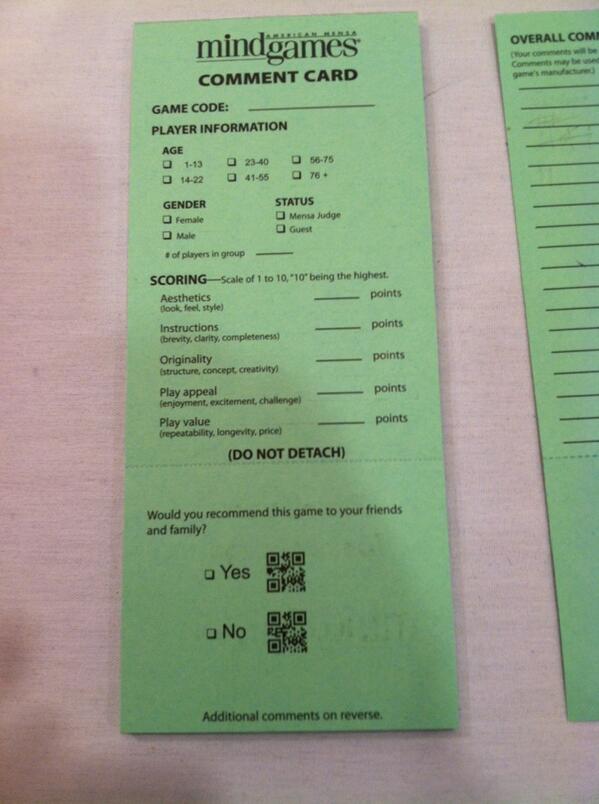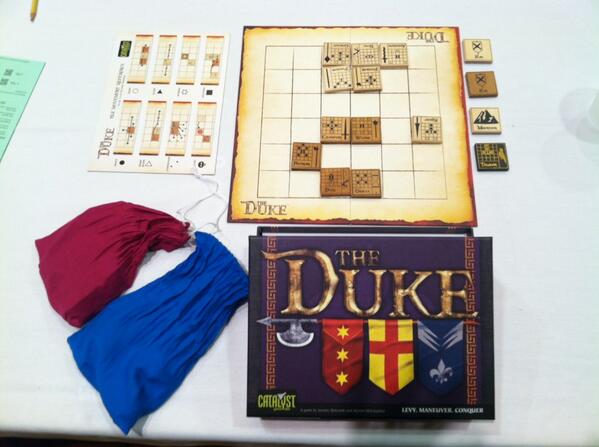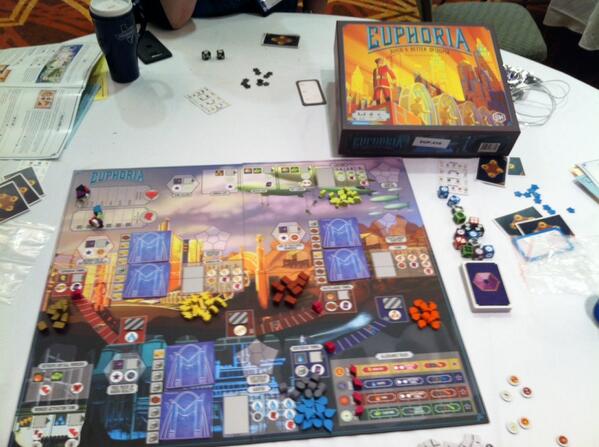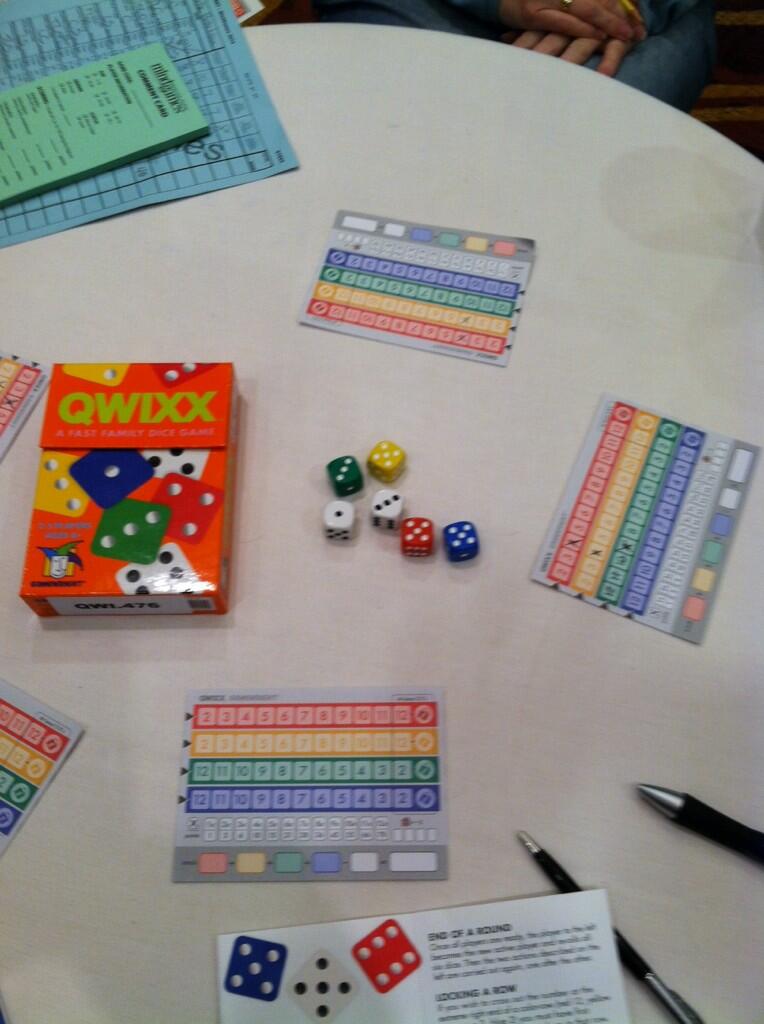This is an important topic! Board gaming is experiencing a renaissance, and more and more, “mainstream” shoppers will be looking to “experts” in the tabletop gaming industry for recommendations. It’s important we learn to speak the same language and not be all over the map (despite the fact that we are, literally, all over the map) when we are discussing certain aspects of our increasingly popular hobby. SCROLL DOWN FOR THE LIST ITSELF!
In my last post on the subject, I laid out four criteria that should be considered for making a “family” game: Cross-Generational Appeal, Bonding Elements, Family Friendliness, and Simplicity. There are MANY games that meet several of these criteria extremely well, and those games exist on many lists of favorite family games, but in order to make this list, a game has to meet ALL FOUR criteria.
Cross-Generational Appeal seems obvious enough, because a family is by definition a multi-generational group. A great family game is one that can be engaged in and enjoyed by the kids, the adults, or the seniors, and most importantly, by everyone at the same time. There is a natural social barrier between youngsters and oldsters that a great game will help break down, sometimes by allowing kids to show sophisticated strategy or a demonstration of knowledge, and sometimes by allowing grandpa to cut loose, relax, and laugh. Or vice-verse. The key is a game that every player has equal access to, is equally challenging to everyone, and is equally likely to result in a satisfying challenge or a laugh. There are all-time great party games that families have always enjoyed, but they’re often best enjoyed with age-mates who know the same references and are more likely to have equal skills or knowledge. On the other hand, games typically considered “family games” are actually just kids’ games, and are not equally challenging, fun, or appealing to adults.
Bonding Elements exist in games that offer the opportunity for players to engage their own wits, or games that involve funny situations or references that everyone can laugh at – and nothing bonds like sharing a good laugh. The right game will instantly melt a generational barrier, and memories are made that can literally last a lifetime. Another angle on bonding can arise from thematic games, if it’s a theme the whole family is already attracted to. Team games (sometime requiring a bending of the rules) are often great ways to pair up people from different generations, and the anxiety and exhilaration brought on by game situations has a way of cementing relationships. There is a whole “new” (not really new, but now much more visible and popular) category of cooperative games that pit the players against the game itself, and there is nothing like a common struggle to bring people together. In any case, the players are emotionally involved at the same time and at the same targets.
There are some great games that are R-rated or worse. Some games have sexual content (e.g. Cards Against Humanity) or exceptional violence (e.g. Kablamo) that are simply inappropriate for kids. Still other games have a cutthroat element that would be unseemly between adults and kids if used as intended (e.g. Diplomacy). A great game is therefore Family Friendly. Even if the kids are old enough to deal with certain topics, older generations often feel embarrassed to find out about it. It is often hard for even a 20-year old to play the sexy santa card in from of Grandma. There is not much more awkward than a bewildered kid at the table when these topics arise, and the enjoyment for all is lessened as a result.
Finally, the rules and strategy of the game must be relatively simple. Simplicity kind of goes without saying, but the recent wave of board games are often good because of the interesting complications they introduce. Unfortunately for many, that puts them beyond the reach of children or intellectually challenged adults, or even those many, many adults who are too impatient to read more than a page of rules. If it’s not relatively easy to play right out of the box, and it can’t be taught quickly by a knowledgable player, then it’s less likely to be a great family game. On the other hand, too simple may simply not be challenging enough. Every player should actually have the ability to intentionally affect the outcome of the game.
This list is based on the four criteria I listed above. There are MANY games that are great with families, but these meet all four criteria, and would unfailingly provide challenge and fun for any family. I break them up based on number of players because that of course results in very different contexts for gaming. I also only included games that are on the market:
| 2-player games | 4-player games | 5-8 player games | 9+ player games |
| Mastermind | Cornerstone | Scotland Yard | Telestrations |
| Qwirkle | Pit | Apples to Apples | |
| Rummikub | Uno | Werewolf/Mafia |
2 player games:
– Mastermind (Pressman) Lots of two player games are fun, but they are usually battles of wits. So let’s face it – adults have an overwhelming advantage over children until the child becomes very experienced. Chess, Checkers, Stratego, and many other very good games are imperfect for families because if it’s complex enough for an adult to enjoy, a child will usually be at a disadvantage. Not so with Mastermind, in which one player sets up a code based on colored pegs that the other player must try to decode in a minimum number of turns. Siblings can play each other, parents can play their kids, and grandparents can play their first grade grandchildren and still enjoy it. It’s centuries old and it’s a game that every household should have.
– Honorable Mention: Chess and Checkers and Backgammon and Chinese Checkers. These are easy and can be challenging, and exist in many many incarnations everywhere. Every home needs them.
3-4 player games:
– Rack-O (Milton Bradley) This game goes back to 1956, and consists of cards numbered 1-60. Players alternate drawing cards and placing them in one of ten slots in their specially designed rack, with the ultimate goal of being the first to get all ten cards in order. The rack is initially filled in a random order, and on each turn players decide whether to draw face-up from the discard pile, or from a face down pile, and then where in their rack to place it – and thus which card to discard. It’s simple, challenging, and after one or two plays any advantage an older person might have is gone.
– Cornerstone (Good Company Games) A more recent addition to tabletop gaming (2008), Cornerstone combines building skill with pawn movement with probability. Unit blocks consist of 1-6 units in various shapes and composed of checkerboard-pattern sequences of cubes of natural wood and cubes that are one of four colors (one for each player). Players roll a die to determine which piece they must use (1-6 units), then add it to a common tower in such a way that it maintains a checkerboard pattern, THEN they must try to move their pawn across neutral or own-colored blocks to occupy the highest possible position, one step at a time. This game can be enjoyed by just about anybody – it requires some physical skill but not a lot, some strategy but nothing complex, and it gets very tense, especially towards the end.
– Qwirkle (MindWare, 2006) is another relatively recent board game, which shot right through the independent outlets into mass retail. Qwirkle is essentially a rummy-type tile-laying game, in which players alternate the placement of tiles to create interlocking rows and columns of tiles that have either the same color and different shape, or the same shape and different color. Points are scored for laying tiles and for obtaining a “qwirkle” – a lineup of six tiles, six being the number of different shapes and colors. The set-making requirement of Qwirkle is simple enough for youngsters to grasp right away, the tiles are large and easy to manipulate for young and old hands, and the patterns that result from gameplay are attractive.
– Honorable Mentions: Scrabble should be in every household (see chess etc above), even if adults have a decided advantage over kids, and some people love word games more than others. Labyrinth is a game of shifting passages that has been around for several decades and is universally loved. Sequence is another game that lends itself to family play very well, and can be played in teams. Blokus is a colorful tile-laying game that’s easy to learn and play but probably favors adults. Pandemic is a relatively new, cooperative game that is on many lists of favorite family games, but it’s a little complex (can’t be explained in just a few minutes), and while children can keep up, it’s the adults who stand a better chance at leading to a win.
5-8 player games:
– Pit (Parker Brothers, 1904) is a personal favorite of mine. Any group of 5-9 can grab this game and play. It only takes a minute to explain, it’s fast-paced (but even the slow have a chance to win), and it’s loud. It pretty much embodies the aspects of a lively family get-together. Pit is based on commodity trading. There is a 9-card hand of commodities (such as sugar, wheat, corn, etc) for each player in the game; all cards are shuffled and redealt, and at the sound of a bell players start trading in order to try to achieve a full hand of a single commodity. Trading is done with any other person at the table, one trade at a time, for up to three cards (of a single commodity) at a time. When a player does “corner the market” they yell “Pit” and the round is over. Different commodities gain differing point amounts, and those points go to the winner of the round. This is a game that granddads and granddaughters can play, with sibings and parents and cousins of any age joining in, and it’s hard to play without a lot of laughs.
– Uno (Mattel, 1971) is typically seen as a kids’ game, most likely because it’s so easy to learn and so easy to carry around (It’s just a deck of cards). But adults can play and enjoy it just as well, and any age range can easily sit down and have a fun time playing. It involves several decks of various colors with a range of numbered cards as well as “penalty” cards in each color and wild cards. The goal in each round is to be the first to go out, and failing that to minimize the number of points in your hand. The fun of Uno stems from the penalty cards. They are worth more points (so getting them stuck in your hand is very undesirable), but they alter the game by reversing the order of play, requiring a player to pick up extra cards, or skipping the next player. There is also a wild “draw four” card that has ruined many a game for a player about to go out. This game has been around for a while, and exists in many different forms and variations today.
– Scotland Yard (Ravensburger, 1983) is a cooperative game – mostly – because one player acts as a criminal and the other players team up to capture the the first. Play begins on a map of London, where the criminal (“Mr X”) is hidden and the “detectives” are spread out. Each player has a set of transportation passes: Taxi allows movement from one block at a time (node to node) on the map, bus allows movement several blocks at a time, and subway allows movement many blocks at a time. Mr X will move several times, only revealing his mode of transportation, then “surface” after three moves and then every five. This leaves the detectives to deduce the criminal’s future location, which, in order to capture Mr X, they must land on while occupied. Mr X also has a couple of “boat tickets” that allow escape by river, and two 2x move tickets that allow two moves at once. All in all there is a lot of positive energy (tension and release) and a great opportunity for adults and kids to work together to find the criminal, not to mention the logical thinking inherent in the game.
Honorable Mentions: Lest I forget, Dominoes and Playing Cards are must-haves in every home. There are unlimited possibilities for domino and especially card games, and many gaming families have their roots in card games. Clue is a classic for a reason – another game that involves logic, and never fails to offer a challenge for all ages. The 5-8 player category is absolutely FULL of great, newer generation games that would be suitable for many families (if not all – the young don’t stand a chance to win a fair competition against their elders). Some popular titles include Ticket to Ride, Carcassone, and Settlers of Catan. Finally, there is a slew of new cooperative games that are a lot of fun to play and are also family favorites according to many other lists: Forbidden Island, Forbidden Desert, and Flashpoint each require players to work together and beat the game – and winning almost always comes down to the last possible play or two, so they are exciting.
9+ player games:
Werewolf/Mafia (1986): In the now classic parlor game of Mafia from 1986 and nicely packaged in various ways today (i.e., Werewolves of Miller’s Hollow; Asmodee, 2001), Players gather in a single room and face each other, while the moderator sets the scene of alternating days and nights. Players are randomly and secretly assigned a role as either an innocent or a killer (mafioso or werewolf). At night, the town goes to sleep (all shut their eyes), then the bad guys awaken and silently indicate to the moderator their choice for the next victim, who is then informed by a tap. When morning comes, the victim is discovered and the troubled innocents choose who will hang for the crime. The bad guys have to blend in and try to avoid being hanged, while the innocents have to try to identify the bad guys and hang them. This is all in all an intense but very fun game, and there are many variations on it. Kids can participate as readily as an adult, and any number that can fit in a room is okay.
Apples to Apples (Out of the Box, 1999) almost immediately became a family favorite when it came out. Its then unique mechanism of players matching noun cards with target adjective cards in the hopes of a single “judge” liking your match best has been imitated a lot since then. It did originally suffer from the problem of younger players not being familiar with the subjects of every card, but kids and then family versions came out, and now there are many variations. Kids and adults alike are unfailingly amused to see what card combinations are made, as well as the reasons people might give for choosing one match over another.
Telestrations (USAopoly, 2009) is relatively new, but just like Apples to Apples, it soon became ubiquitous. It originally played just 6, but a few years late they published a 12-player game, and as in any good party game, the more the merrier. It is essentially a variation on the old “telephone game:” players start with a word or phrase written on a spiral pad, which is then passed to the next player. The next player attempts to draw what the first player had written, and passes the pad to the third player, who then writes a word or phrase to describe the drawing. Player four draws it, player five writes it, and so on around the table. Just as the telephone game (which is simply the passage of a message around a circle) results in garbled or wholly different messages, the final result of a round of Telestrations is rarely identifiable – but it is almost always hilarious. The whole family can play (or it can be played by age-mates alone), everyone plays at the same time, and everyone has a good time without fail.
Honorable Mentions: Games of 9 or more people are almost by definition party games, and most party games are adaptable (either by editing or teaming up) to children. Some, however, are better than others, if not as good as my top three choices. Charades-style games in which teams try to guess a target item from a clue-giving teammate are great: Taboo, Time’s Up, Catchphrase, and Reverse Charades are all a lot of fun. Trivia type games are good when either designed with kids in mind (Kids versus the Grown Ups) or when even teams are possible (20 Questions, Trivial Pursuit, Wits and Wagers). Games involving manipulation, drawing, or skill are also fun when edited or with teams: Cranium, Pictionary. A couple other very unique games are worth mentioning: Set involves the speed-identification of sets of matching or mutually exclusive elements, and Headbanz is the board game version of the old 20 questions game, in which players ask yes/no questions to deduce the identity of a card held on their own headband, for all others to see.
So there it is. I welcome real conversation about this list and my criteria, as opposed to votes for this game or that game. I wouldn’t hesitate to recommend these games to ANY family, whether they are serious board-gamers or just looking to do something fun over a holiday weekend or on a slow weeknight. Either way,

















